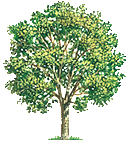State
Bird
Hermit Thrush

|
The
Hermit Thrush was voted as the state bird in 1927, but it did not
become official until 1941. One of the reasons it was chosen was
the sweet delicate song it produces. The bird is found throughout
Vermont during warm weather, but in the winter it flies to warmer
climates. However, it is one of the first birds to return to Vermont
in the spring. Its length is six to seven inches. Its upper body
is a brownish to grayish color, and it has a white breast with dark
spots. The bird's legs are pink.
Top Of Page
|

State
Flower
Red Clover
 |
In
1893 the people of Vermont began selecting their state flower.
The Red Clover won with as much as four times more votes than
any other flower, becoming their state flower in 1894. English
colonists brought Red Clover to the United States. The flower
can be seen growing in thick clusters throughout the state. The
flower grows one to two feet in height and has a red stem.
The clover is very important to raising cattle; it is one of their
main foods. Farmers learned the clover contains vitamins that
are good for their cattle and soil.
Top Of Page
|

State
Tree
Sugar Maple
 |
The
Sugar Maple is the most popular state tree, representing four states
including Vermont. 1949 was the year Vermont chose the Sugar Maple
as their state tree. Sugar Maples have short trunks and large thick
tops or crowns. They grow 60 to 75 feet in height. As autumn approaches
their green leaves change to orange, yellow, and red. Their wood
is used to make furniture, but as winter approaches sugarmakers
drill holes in the trees and insert spouts with buckets hanging
from them. When the temperature rises above freezing, the sap (a
sticky brown liquid) begins to flow into the buckets. The sticky
thick sap is made into sweet maple syrup.
Top Of Page
|

State
Flag
Click
on flag to view
larger image.

|
When
Vermont became a state in 1791, Kentucky followed a year later.
At that time, the United States flag displayed thirteen stripes
and thirteen stars, but Congress changed
the design of the U.S. flag to contain fifteen stripes and fifteen
stars representing Vermont and Kentucky. Vermont's first flag was
similar to the nation's except that it had 17 stripes and 17 stars,
because Tennessee and Ohio had just joined the union. In 1817 Congress
again changed the design of the nation's flag to 13 stripes and
a star for each state as you see it today. Vermont changed their
flag's design one more time before 1919and adopted the current flag
in 1923. It was based on the state seal designed by Ira Allen.
The
current flag displays Vermont's coat of arms on a blue background.
The coat of arms shows a landscape painting of the Green Mountains.
The cow and wheat sheaves represent the importance of farming in
Vermont. The pine tree in the center stands for Vermont's forests.
The deer head on the top is a symbol of Vermont's wildlife. The
pine branches on each side of the coat of arms reminds us of the
Vermont troops who fought against Great Britain in the Battle of
Plattsburgh in 1814 during the War of 1812. The
word "Vermont" and the state motto
"Freedom and Unity" are shown on a crimson, deep purplish red color
banner. The idea of unity has always been important to the United
States because it is what make us one nation.
Top
Of Page
|
|
